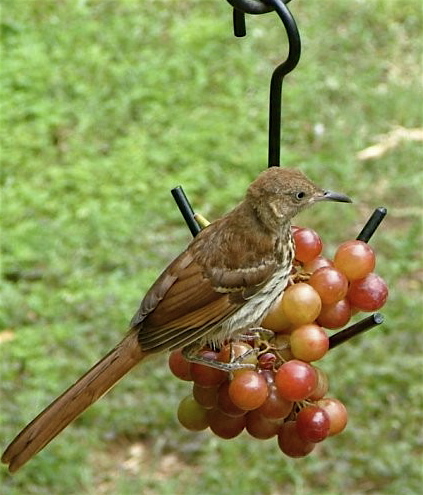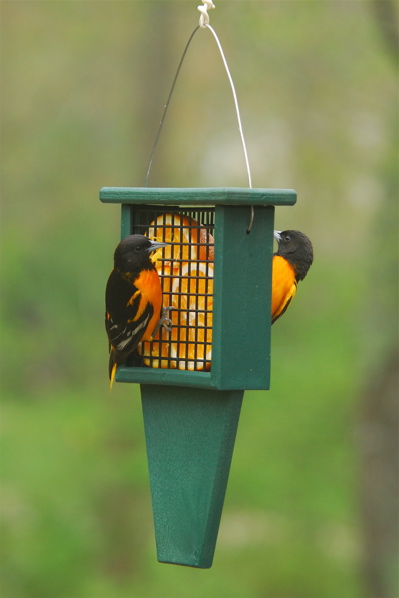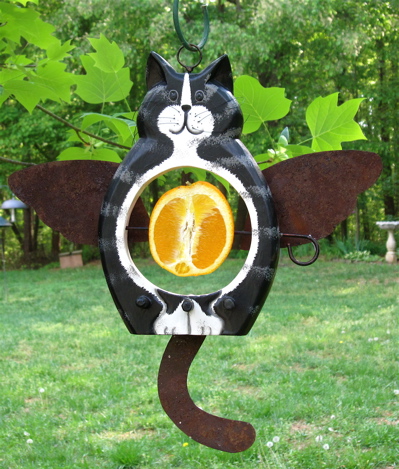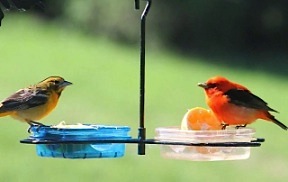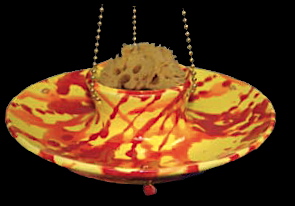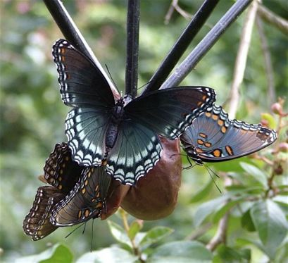-
do fruit in wild bird feeders for summer season!
The best of summer… when everything seems bolder and more alive. Gardens pop with vivid color, and many birds’ plumage is at its brightest before molting. Colorful fruits are also a great idea for wild bird feeders! Migratory birds (as well as a few residents) enjoy various fruits as part of their healthy diet too 🙂
Adding a new dimension to feeding wild birds, fresh fruit offers great variety for many species, there’s just so much more than plain old birdseed. Staked, platform and open dish feeders accommodate many types of foods – allowing you to change things up with seasons. Got a suet feeder? Simply try orange slices for orioles, woodpeckers, cat birds and others.
Some staked and dish feeders are far from boring, fun designs to add a splash of color, or even bring a smile to say any cat enthusiast! With these wild bird feeders, suet is perfect for winter feeding too, and there’s lots of recipes online (and on our site) to make your own. Large formed balls work best on the pin, and by mixing a big batch, it’ can be stored in the freezer for ease of use.
Because variety is the spice of life, mix it up for your feathered friend this summer! You never know who may stop by, and after all, you can always revert to boring birdseed in your feeders!
- Bird Feeders, Fruit Bird Feeder, Fruit, Jelly & Mealworm Feeders, Live Meal Worms, Mealworm Feeder, Uncategorized
live worms escaping your mealworm feeder?
A customer’s question grabbed our attention: “How do you keep the worms inside the mealworm feeder?”
Tooth, texture… that’s what it’s all about here. If the surface of the feeder is not smooth as glass, the wiggly, crawly delights get hold and simply crawl right out! Now this is a huge advantage to ground feeding birds like robins – ours actually sit and wait below the mealworm feeder. But for bluebirds, chickadees, nuthatches, warblers, swallows and titmice, they have to swoop down to catch their worms if they’ve all crawled out.
So what’s the point of using a hanging dish feeder if worms end up on the ground? Not much! If you’re feeding live worms, it’s best to use a feeder that has absolutely no texture on the inside surface. Worms will stay put longer, and while juveniles are learning to use feeders, this is helpful.
An open dish type feeder will also accommodate a good variety of other treats to entice wild birds. Oranges used in this double-dish model have orioles flocking and teaching babies where the good stuff is! Suet chunks and peanuts are also good options for winter feeding.
Smooth, plexi-glass meal worm feeders like this are available in staked, hanging and even pole-mounted options. They’re durable for year-round use and dishwasher safe. Birds can perch anywhere on the dish – making it easier to land and feed. The vertical hangers are long enough to use with a weather guard, or even a baffle should squirrels be a problem around your place.
If you’re on the squeamish side and can’t bear the thought of live worms, birds will also go for dried worms. In fact they pack more protein per serving! Consider a dish style mealworm feeder this season… they work great for more than just worms!
- Bats & Butterflies, Bird Accessories, Butterfly Feeder, Fruit Bird Feeder, Squirrel Feeder, Uncategorized
Unusual Butterfly Feeders offer great versatility, and a cool metamorphosis video too!
Love cool stuff! These butterfly feeders(coming soon) do double duty for fruit lovers like; Warblers, Thrashers, Woodpeckers, and lots of other migratory friends who adore fruit and/or jelly. An Oriole’s favorite, the center may be filled with jelly, while orange quarters are placed right along side.
As a nectar feeder for butterflies, the sea sponge is included. It acts as a wick-absorbing the liquid because butterflies will not drink from an open source. This method recreates how the flying gems actually draw nectar from flowers. Over-ripened fruit may also be placed on the outer dish, offering butterflies a varied and swell refuge.
Handcrafted of weather-proof stoneware, lead-free glazes, and brass chain, it’s safe outdoors year-round. The feeder may also be placed in the dishwasher for a quick & thorough cleaning. Lure butterflies to your place offering nectar and fruit together in this groovy, hand-made feeder.
And speaking of fruit, butterflies enjoy a variety of over-ripened ones. Grapes, oranges, melons, peaches, apples and berries will entice them to nibble and come back for more. This durable stalk feeder is perfect for creating a fruit smorgasbord, even corn on the cob works well in winter after butterfly migration is complete. (Yes… some folks really do feed the squirrels!)
Of course habitat plays a key role in attracting butterflies, and omitting pesticides will prove most beneficial. Nectar-producing flowers (lantana, abelia, and butterfly bush) are most common, and should be included in the landscape. Host plants are also required, and will likely deteriorate with munching! Milkweed, parsley and cabbage are a few favorites caterpillars love (and need) for growth to chrysalis stage.
Ever witnessed the stages of a butterfly metamorphosis? Until seeing the video below, I can’t say that I have! Truly a masterpiece of nature, it’s worth the watch!

